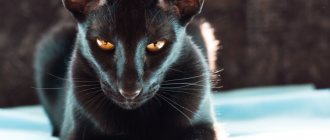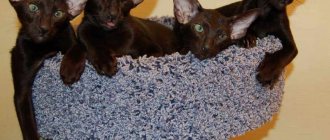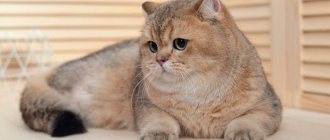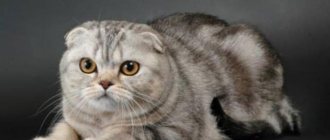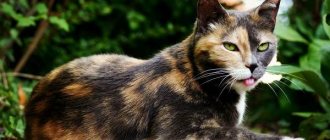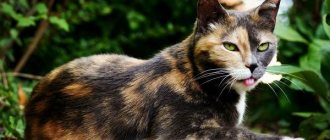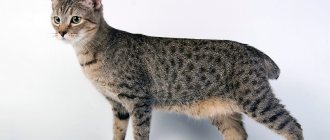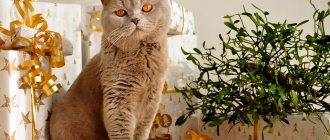An Oriental cat is a representative of the feline family, possessing special grace, elegance, and beauty. The abbreviated name is Orik, Orients or Orientals, the breed is part of the group of Siamese-Oriental cats. They are also called “Oriental”, “Asian”, “Ori”.
This is one of the brightest and most diverse cat breeds - there are about three hundred types of colors. No one else has such abundance. Added to the striking appearance is developed intelligence, sociability, activity, and playfulness. What makes the Oriental breed the best option for a family with children.
Oriental cat.
Description of the Oriental cat breed
Popularity 48th place among 87 cat breeds
Lifespan:
15-20 years
Height:
23-25 cm
Country of origin:
USA, UK, Thailand
Average price:
30-45 thousand rubles
Weight:
3-8 kg
Latest articles Cat health
Ataxia in cats: what it is, how it manifests itself and is treated 01/23/2022 151 0 0
Cat health
Leukemia, or viral leukemia in cats 01/23/2022 140 0 0
How to choose a kitten
The baby must be purchased from a nursery. Carefully check all documents and the presence of pedigrees. Find out additional information about the nursery, study the nursery website, reviews on third-party resources. You can come to the exhibition and chat with Oriental breeders, learn more about the breed. Cat lovers' clubs often host seminars on breeds, where you can also learn a lot of important things and talk with cat breeders.
If you want an Oriental of a certain color, you may have to wait several months for a certain kitten. Responsible breeders do not give away kittens before 12 weeks.
The cost of a kitten depends on its type . Extreme type kittens are more valuable. The price for kittens starts around 15-20 thousand rubles. A kitten for breeding will cost 50 thousand rubles or more.
Key facts
The Oriental cat is impressive with its appearance, which suggests its alien origin. She captivates with her refined grace and elegant silhouette. The description of the Oriental cat breed states that the peculiarity of animals lies in the ability to win over any person, even if he does not like cats.
The developed intelligence of the pet helps to feel any mood swings of the owner, who is simply a deity for him. However, cats require no less attention to themselves. The characteristics of the Oriental cat emphasize that their favorite place, where they can spend quite a long time, is the owner’s lap. With a lack of attention, eared animals begin to meow loudly and persistently.
Most of the representatives of the Oriental cat breed live in their countries of origin. These are several countries that have become home to animals: England, the USA, but above all, Thailand. The abbreviated name for these animals in Russia is orik.
Oriental males are slightly larger than females, who look more elegant and have a more refined silhouette. In general, the weight of male cats can range from 3 to 5 kg. The life expectancy of an Oriental cat is above average. It lasts 15-20 years, which is why they are called a long-lived breed.
Breed card
| Characteristics of a cat | Notes | |
| General information | Oriental cats come from the Siamese line. It was from the Siamese that a strong character, playfulness and piercing eyes were passed on, although not necessarily blue. | Monochromatic cats are more popular |
| Character | Very affectionate, talkative and active cats. They require a lot of attention and will seek it using any available method. | |
| Appearance | Smooth-haired, elegant cats with a thin, elongated body and a triangular head. Lots of colors, some potential combinations haven't even appeared yet | |
| Behavior at home | They miss their beloved owner, so if you are away from home for a long time, get two Orientals. Being in a pair, cats will not be so bored and will not destroy the apartment in search of entertainment. They like to tap their paws on the floor to attract attention. | A very talkative breed. The voice of Orientals is loud and similar to the cry of a child, and sometimes even to a car horn. |
| Care | Short hair requires minimal grooming. It is enough to comb 1-2 times a week | Oris love the ritual of combing very much, because this is additional attention from the owner |
| Health problems | Sometimes hereditary heart disease | |
History of the origin of the Oriental cat
According to genetic data, the Oriki are the closest relatives of the Siamese. At the beginning of the 19th century, both breeds began to appear in European countries, the USA from the country of origin - Thailand. But then they were not divided into two independent breeds, but were considered classic Siamese individuals with other color options.
Ushastikas did not make an impression at special exhibitions or shows. They were often disqualified for non-standard coat color and green iris.
Representatives of the Oriental breed were not popular. It was only thanks to the work of enthusiasts that they did not disappear from Western Europe. In America, in 1923, the Siamese fan club banned their breeding altogether, leaving only individuals with blue eyes and Himalayan coat color.
For 30 long years, orientals were in oblivion, until in the middle of the last century, a fashion for the unusual, even extreme exterior of mustachioed animals began in the United States and Great Britain.
Breeders began to develop a new species of Siamese with a uniform coat color. To do this, they were crossed with breeds with short hair, including Abyssinians.
In 1977, Orientals were recognized almost throughout the world as an independent breed, with the appropriate standards assigned. True, these characteristics were almost identical to the Siamese, with the exception of the points about the body and colors.
Interesting fact: breeders from Foggy Albion were in no hurry to recognize the original origin of the Thai breed. For 20 years they studied, compared, evaluated. It was only in 1997 that Orientals gained recognition as an independent breed in the UK.
A little history
In the 19th century, the Siamese cat became a guest at an English exhibition, where its appearance became a real sensation.
Later, breeders began crossing Siamese with female shorthaired breeds. This is how the Oriental cat breed was developed.
What does an oriental cat look like?
Muzzle
The general impression of Orientals is formed already at the first meeting. What does an Oriental cat look like? These are extremely graceful individuals of the Asian type with a hypnotizing gaze. Even the photo of an oriental cat shows that it has an unusual character.
The cat's head, according to the rules of the standard, has a flat frontal part and a very prominent profile with a clearly defined chin. The skull should be shaped like a triangle. The muzzle of the breed is narrow with a smooth, somewhat elongated nose, located at the same level as the chin.
The pet's bewitching, slightly slanted eyes have an almond-shaped cut. By standards, the distance between them is almost equal to the length of one eye. Orientals can only have one iris color – emerald. Blue coloring is allowed in albinos.
Separately, it is necessary to mention the cat's ears. They are quite massive compared to the size of the head and, due to their wedge-shaped shape, seem to be an extension of the muzzle. The ears are thin but wide. They begin to grow actively from the first months of a kitten’s life.
Body type
The body of the animals is very slender, elongated, with strong dry muscles. The neck is long and very graceful. Thanks to this physique, representatives of this breed look very graceful and elegant.
Characteristic of Orientals are elongated hind and forelimbs, giving them lightness and a certain airiness. Thin paws have strong bones and well-developed muscles. The paw pads are royally small and oval in shape.
The cat easily picks up speed and runs quite quickly, and can overcome high obstacles. Her movements are smooth and graceful.
The animal uses its long tail as a rudder. It is shaped like a whip and ends with a sharp tip. The rest of the tail is the same width.
The length of the cat’s body reaches 90 cm, and the height of the pet is about 25 cm. At the same time, female individuals are slightly smaller than males.
Coat and color
The coat beautifully and softly outlines all the contours of the cat's body. This is possible due to the fact that there is almost no undercoat. The hair of a smooth-haired Oriental is satiny, shimmers and shines in the sun. Long-haired individuals have silky, fine hair. The tight fit of the hairline to the body visually conceals the length.
Breeders distinguish quite a few varieties of Oriental cats based on color. This sets the breed apart from the more stringent standards of other felines. The color of an Oriental cat can be coal-black, snow-white, delicate pastel shades, tabby, and even point colors are found.
To organize such a variety of colors, they were divided into basic types: lilac, blue, red, Havana or brown, white, cream, ebony or black, fawn (beige), cinnamon (cinnamon).
Of the tabby colors, the spotted, brindle, harlequin and ticked subtypes are considered more desirable.
Colors
Currently existing standards provide not only solid color. Many others are allowed: tabby, bicolor, smoky, darkened, tortoiseshell, voile. Colors are allowed in a range of shades: black, red, blue, chocolate, cream, white and various versions of tortoiseshell.
In the photo, popular colors of Oriental cats: smoky, tortoiseshell, tabby
Character of an oriental cat
The character of the Oriental cat is sociable; these animals love to play with family members. Those who have adopted Orik breeds speak of their sincere desire to spend as much time as possible with their beloved owner. They are not as independent or arrogant as other mustachioed pets.
This breed is well suited for those who dream of having a dog, but cannot do so for a number of reasons. The Asian woman exhibits the behavioral traits of a dog. They follow the owner's heels, trying to control his every step. Orientals will not lie quietly on the sofa: they need to run, jump, and move a lot in order to waste their irrepressible energy. Therefore, the sofa will most likely become a springboard for jumping to a higher obstacle.
These cats are not suitable for those people who are very worried about the interior of their house or apartment. The increased jumping ability of a pet will be fatal for glass vases and other fragile objects. All sorts of mice, balls or teasers, bought in large quantities for your favorite bandit, will help to distract you a little from such pranks. Adults and even elderly cats never cease to amaze with their enthusiasm and energy. They are ready to play with candy wrappers, jump on furniture and climb curtains without a break to rest.
Eared pets have a burning curiosity. They will not be able to pass by a box, bag or other container. Their contents will soon cease to be a secret to them. If you don't let them into the room or close the door in their face, they will consider it a big punishment and may even be briefly offended.
Orics do not tolerate loneliness well, so if you do not have enough free time, it is better not to choose this breed. Persistent meowing accompanies cats almost always and everywhere. By this they want to attract the attention of their adored owner to themselves and talk to him. The timbre of the voice of Orientals is quite pleasant and inviting.
Cats of this breed relate well to children; they are quite willing to spend time with them, take part in their games or pranks. Asians get used to living with other animals. They accept cats right away, but they prefer to watch dogs first, but then the relationship improves. Living with other pets, they can more easily tolerate separation from their beloved owner.
Pros and cons of the breed
Orientals have their advantages and disadvantages. Before purchasing such a kitten, it is worth studying them. The advantages of Asians are:
- unusual appearance;
- active, flexible, cheerful;
- the unusual shape of the muzzle is the main distinguishing feature of the breed;
- developed mind;
- training ability;
- high ability to communicate with people;
- there are no special conditions of care and care;
- affectionate and gentle;
- hypoallergenic.
The disadvantages of the Oriental breed are:
- touchiness;
- require a lot of attention from the owner;
- it is necessary to arrange an active lifestyle;
- They cannot tolerate cold or even relative coolness; the optimal room temperature for it will be 22-24 C.
Only by weighing all these features can you decide how well this breed suits the preferences and wishes of a particular person. If you like to spend a lot of time with your pet, play with it, caress and stroke it, then such an animal is completely suitable.
Raising an Oriental cat
It so happened that genetically Asians inherited a sharp mind and well-developed intellect. This explains their high ability to learn and train. For example, they can easily master a number of simple commands or retrieve a thrown object.
Despite this, cats love to mischief and are also capable of minor mischief. Rules of behavior and etiquette must be instilled in the kitten from the moment it appears in the house, otherwise curtains or flower pots will be in danger of being destroyed. It is difficult for cats to understand their guilt, so the owner must patiently point out his misdeeds and not leave pranks unattended.
Judging by the intonation of the person’s voice, the Oriental will quickly understand his mistake, and repeated expressions of dissatisfaction on the part of the owner should reduce the problem to nothing. They have well-developed intuition. But you should not hit or physically punish your pet; raising an Oriental cat in this way will not lead to anything good.
Your pet should learn to use the litter box at an early age and not confuse it with other containers or even shoes. Usually, there are no problems with how to toilet train an Orika. Representatives of the Asian breed are very clean individuals, so they strictly adhere to hygiene rules.
Looking for an Oriental cat? Find your pet from 2 offers Buy as a gift
Education and physical activity
Like any other oriental cat, the Oriental is endowed with high intelligence and developed mental abilities. He quickly learns the rules of behavior in the house, gets used to the tray and remembers simple commands. If desired, the Oriental can even be taught retrieval.
Cats of this breed are endowed with an active temperament and remain playful until old age. Therefore, it is advisable to purchase interactive toys and arrange a corner with ladders and shelves so that the Oriental has a place to splash out the accumulated energy.
Oriental cat health
Possible diseases
Oriental cats cannot be called the owners of good health. Despite the fact that on average they live 15-17 years, they are characterized by a number of diseases inherited from their Siamese ancestors.
The most common genetic disease among representatives of the breed is liver amyloidosis, which leads to liver failure, and in its neglected form, to the death of the pet. The symptoms of the disease are quite specific, but if activity weakens and appetite deteriorates, you should immediately contact a veterinary clinic for advice.
Problems with the functioning of the heart are caused by a disorder in the myocardium, this is the so-called dilated cardiomyopathy. Diagnostics using an ultrasound machine, which is done every six months of the oric’s life, will help prevent it.
Unusual, slightly slanted eyes can also cause unpleasant moments. In addition to inflammation and conjunctivitis, hereditary strabismus and retinal atrophy are possible.
Flat chest syndrome in newborn kittens leads to underdeveloped lungs and death from suffocation if the baby is not noticed and treated in time.
The large ears of an Asian cat are prone to otitis media and inflammation. If the problem is not dealt with in time, you can end up with an animal with hearing loss or complete hearing loss.
An incorrectly selected diet can lead to obesity or the development of food allergies in pets. Because of this, the state of health is impaired, and the appearance of the coat deteriorates, which becomes dull and begins to shed more.
Reproductive health
A cat becomes sexually mature by 1-1.5 years of age. At the same time, mating of seals and female cats of this breed is allowed. It is not worth doing this earlier, because the female’s body will not be completely ready to bear and give birth to healthy offspring. Cats that are too young produce non-viable or unhealthy litters.
Pregnancy and childbirth among Oriental women do not have any peculiarities unique to them. Like all felines, they may need human assistance during lambing. There can be 3-7 kittens in a litter.
Females and males become caring, responsible parents.
Females can be sterilized after a year of life, and boys can be castrated at the age of 6-7 months. The health of a cat directly depends not only on care, but also on timely sterilization - unless, of course, breeding is planned.
Diseases
This breed is considered relatively healthy, but Orientals are predisposed to the following diseases:
Cardiomyopathy is a group of non-inflammatory heart diseases. The disease can occur unnoticed by the owners and “come out” only in a stressful (for the animal) situation. The animal develops shortness of breath, vomiting, prolonged weakness, and a drop in temperature. The cause of the disease is not fully understood. Treatment: ACE inhibitors, diuretic, calcium channel blocker. Prevention: high-taurine diet, minimum fat and salt in food, weight control.
Gingivitis is inflammation of the gums around one or more teeth. The cause may be untreated caries, plaque, nutritional deficiencies, viruses, infections, or radiation. The animal's gums turn red, and when pressure is applied to the gums, blood appears. The cat becomes lethargic and irritable and refuses to eat. Her mouth stinks. In severe cases, taking medications, treating the mouth with a disinfectant solution, using ultrasound, or removing a tooth will help.
Liver amyloidosis is a hereditary disease associated with impaired protein metabolism. Mostly older animals (over 7 years old) are affected, but sometimes the disease is also diagnosed in children. Females get sick 2 times more often than males. The cat begins to vomit from time to time, she runs to urinate in the tray more often and drinks a lot, stops eating, and loses weight. Edema and ascites appear. The animal is put on a low-protein diet, and drugs that relieve intoxication are infused into the veins.
Expert opinion
Dusheba Vera Ivanovna
In 2010, she graduated from the Moscow State Academy of Veterinary Medicine named after K.I. Scriabin with honors, specializing in veterinary medicine. I regularly attend veterinary conferences, congresses, and webinars.
Kittens, no matter how smart they are, chew everything indiscriminately. Therefore, make your home as safe as possible: hide chemicals and fragile things, sharp and small objects, secure wires higher (or hide under baseboards). Remove houseplants that pose a danger to them (for example, Dieffenbachia) out of sight. Cover the windows with strong nets to prevent the cat from falling out (mosquito nets will not work!).
Features of feeding and diet
The best food option for Oriental cats is high-quality industrial food. The weak, imperfect gastrointestinal tract system of Orientals will not be able to completely digest food from the host’s table, which can cause allergies and disturbances in the functioning of the stomach and intestines.
The owner of the eared cat must decide what food to feed it. You can consider options with dry or wet food, and also alternate between these two types of food. It is important not to mix both types of food in one feeding.
An attentive owner will determine by the appearance of the Oriental what suits him best. The condition of the coat is a direct indicator of the health of the pet's digestive system. With the right type of food and sufficient saturation with vitamins and minerals, your pet’s coat will be soft and silky. The presence of dandruff or brittle hair indicates serious problems with the cat's diet.
To diversify the menu and pamper the Asian, he is given natural products. It can be:
- boiled pieces of lean meat;
- boneless sea fish fillet;
- oatmeal with milk without added sugar.
Often the above-mentioned goodies should not be offered, since the pet can quickly get used to them and then refuse the industrial food that is familiar to it. The second problem is obesity, to which oriki often suffer.
Make sure your pet doesn't overeat. The amount of food in the bowl should correspond to his needs: if there is excess food left, the portion must be reduced.
You can feed kittens according to a strict schedule, starting from a month of age. But adult individuals perceive such fragmented feeding as a hunger strike and begin to stock up on food for future use.
From 1 month of age, animals’ food is enriched with mineral and vitamin supplements. You won't have to do this when feeding premium or higher dry foods. They already contain all the nutrients necessary for a cat’s health.
The constant presence of clean water in the bowl will ensure good functioning of the Oriental's digestive organs.
Character and habits
The Oriental loves to be in the center of the owner's attention and needs human society. A pet, in its love and tenderness, often reaches the point of obsession, preventing the owner from resting and doing business.
The Oriental is talkative, meows in different ways, trying to attract attention. If the owner ignores the cat for a long time, the cat will start screaming like crazy.
Interesting! The pet's voice becomes louder when demanding food, when wanting to defecate, and also during the period of sexual heat.
An Oriental needs to be raised firmly, strictly, but adequately, without rigidity. Oriental cats are extremely touchy and remember bad treatment for a long time.
Training will be easier if you reinforce positive results with treats. Orientals are smart, understanding, they can be taught not only the rules of visiting the toilet and behavior, but also simple tricks, for example, jumping and sitting down.
You should not have an Oriental for a person who loves peace and quiet, and who rarely appears at home. The pet will go crazy from loneliness. An option to solve this problem is to purchase another cat of the same breed, so that the animals are not bored when the owner is away.
The Oriental is an ideal friend for children and willingly participates in children's activities. But relationships with other pets may not work out for him. The Oriental cat is jealous and does not want to share his beloved owner with dogs, guinea pigs and other living creatures.
Care and maintenance
The care and maintenance of an Oriental cat does not require any special skills. They are quite clean, so they can take care of the appearance of their fur on their own. Only during regular seasonal shedding does the owner need to comb out lost hair using a special rubber mitten. A damp towel, to which the wool easily sticks, can help with this.
Bathing is not a necessary procedure for Orientals. Washing is only possible for heavily soiled animals or animals preparing for an exhibition or show.
Like any breed of cat, Asian Oriki need preventative ear cleaning. This is done using a cotton swab dipped in a special cleansing lotion or regular Vaseline. Do not penetrate deeply into the auricle, as this can injure the animal.
Boiled water is used to treat the cat's eyes. This should be done regularly so that dust and dirt accumulated in the corners of the eyes do not cause inflammation.
Owners consider brushing their teeth to be a very painstaking and complex process. The pet does not like this procedure, but without oral care there is a risk of plaque and tartar. High-quality dry food can help cope with them, the particles of which are well cleaned and completely replace the unpleasant procedure.
Wet food lovers are offered treats in the form of special sausages or bones, sold in veterinary clinics.
Regular nail trimming is mandatory when caring for cats. The nail plate of Orientals grows quite quickly, so monthly manicures are necessary to maintain the health of your pet. Kittens are accustomed to the procedure from the age of one month. At first it will be very difficult to do this, but over time they get used to it and quite calmly accept the treatment of their claws. What you may need:
- special nail clipper;
- file for processing irregularities;
- hydrogen peroxide for cuts;
- cotton pads.
The claw should be shortened by no more than 2 mm, so as not to cause pain or damage to the animal.
A distinctive feature of the Oriental cat is its love of potted indoor flowers. Trying their taste is the direct responsibility of the pet. Therefore, when adopting an orik as a pet, it is necessary to remove all poisonous plants, such as azaleas or dieffenbachias.
Danger for your pet can be caused by open windows, from which it will not be difficult for a long-eared bastard to fall out.
How to take care of your eyes
Orientals wipe their eyes daily to remove all discharge.
The procedure is performed using a cotton swab or a piece of soft material, which is pre-moistened in water or tea leaves.
Tips for choosing a kitten
When purchasing a representative of the Oriental breed, you should consider a number of features:
- do not purchase a pet younger than 3 months;
- check documents to confirm pedigree;
- look at the veterinary passport for information on scheduled vaccinations;
- ask to see the conditions of keeping the future pet;
- pay attention to the exterior of the pet’s parents;
- inquire about the type of feeding of the animal.
When making a choice, observe the kitten's behavior. If he was kept with other individuals, then problems with long-term socialization should not arise. But babies kept in cages will be more wild, so it may take longer to raise them.
The kitten's eyes and ears should be clean, without signs of inflammation. The fur of healthy animals is soft and silky, without tangles or bald spots. All Oriental kittens should look good, lively and not cause discomfort.
How to care for your ears
The animal's huge ears require special attention. An oriental black cat or a pet with a different color has delicate skin, so rough manipulations are not acceptable.
For the cleaning procedure, prepare soft cotton swabs intended for hygiene procedures, Vaseline or oil. Do not make rough movements or press on the ears.
Diseases and health problems
By nature, Oriental cats are distinguished by good health and strong immunity. However, there is a list of diseases that are most typical for this breed of cat.
List of diseases of oriental cats:
- Gingivitis. Develops as a result of improper oral care. Manifestations of the disease include bad breath, reluctance to eat, and excessive salivation. To avoid such a problem, it is recommended to follow the rules for oral care, use special care products, and also have your teeth cleaned of tartar by a specialist using ultrasound at least once every two years;
- Amyloidosis of the liver. Occurs as a result of malnutrition. Signs of the disease include difficulty urinating and lack of appetite. The fur becomes dull and lifeless. Problems and disruptions in the digestive tract arise;
- Retinal atrophy. There are practically no signs of manifestation. Only a specialist can diagnose pathology during an examination;
- Cardiomyopathy. Heart disease. Animals lose body weight, become lethargic, and have no appetite. The mucous membranes become bluish;
- Flat chest syndrome. Most often, this pathology develops in small kittens. In older animals, it can cause the death of kittens.
Animals are also very sensitive to drafts, which is why they often develop colds.
What to feed your pets
It is necessary to ensure that the diet is of high quality. You should not give your cat food from the table. His food should not be too spicy or too salty.
Siberian cat - history of the breed, description, character and habits + 95 photos- Maine Coon - history of occurrence, description of the breed, character + 84 photos
- Burma - a cat as a mascot, hygiene and health, character of the breed + 96 photos
Fatty foods are harmful to Orientals. Premium ready-made food is a balanced menu that will benefit your pets.
The animal must be fed at least 2 or 3 times a day. If you want to wean your pet off food, do it gradually. Pour new food into his bowl along with the old one, increasing the dose of the first over time.
Types of purchase
Depending on age, you can buy:
- Two months old.
- Three months old.
- Four months old.
- A six-month-old kitten.
- An adult.
The older the animal, the lower its price will be.
Depending on the color, you can buy the following oriental cat:
- Havana . Characterized by a uniform chocolate color, brown nose, pink-brown pads on the paws.
- Lilac . The coat is gray, the pads and nose are lavender.
- Blue . The color is uniform.
- Cinnamon . Light brown in color with pink pads on the paws and a pink tip of the nose.
- Faun . The coat is light gray or beige. The pads and nose are pink.
- Redhead . It is distinguished by its bright red coat color. The nose and pads are pink.
The most popular are purple and blue cats. That's why they cost more.
Depending on where the purchase is made, it can be:
- At the pet market.
- According to the advertisement.
- In the nursery.
- From the breeder.
Cattery owners and professional breeders sell Oriental cats the most expensively. Cats that are sold through advertisements in newspapers or on the Internet, or at a pet market, are cheaper.
Depending on the class, you can purchase a kitten:
- Pet class (ideal for those who need an Oriental cat as a pet).
- Show class (suitable for participation in exhibitions).
- Breed class (can be used for breeding).
Pet class animals are the cheapest, show class animals are the most expensive.
How to care for claws
It is recommended to cut your nails every month. To avoid causing pain to your pet, you should trim a maximum of 2 mm.
For the procedure, use sharp nippers; accustom the kitten to nail hygiene from the moment it appears in your home; trim one nail per week.
